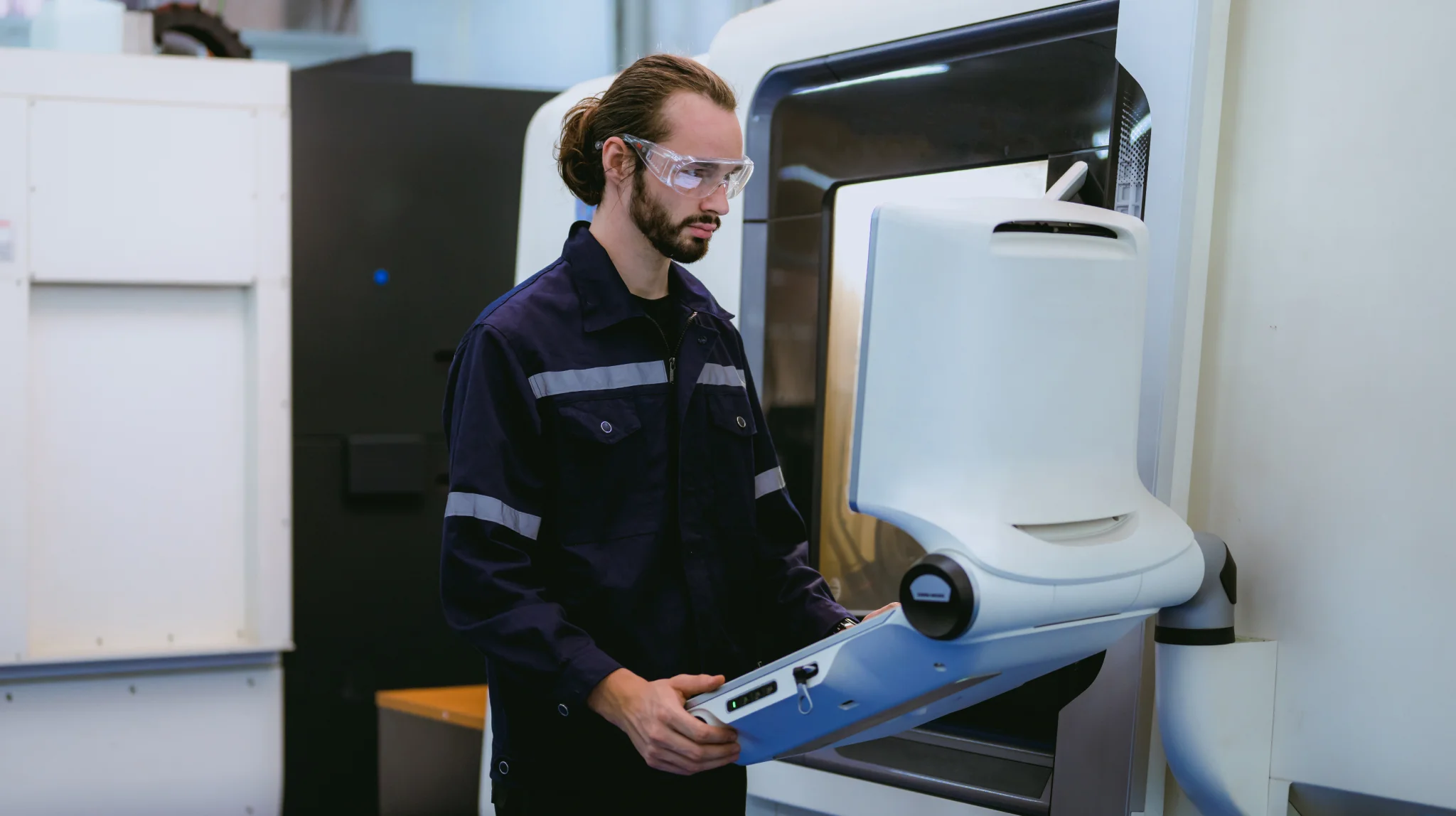How is manufacturing on data-rich platforms different?

July 17, 2025 7 min read
Can you imagine — a milling machine “texts” maintenance five hours before a bearing seizes, the ERP automatically orders precisely 312 sprockets because it sensed a spike in demand, and the energy dashboard seamlessly moves a high-heat batch into off-peak hours – saving more money overnight than your previous Kaizen blitz saved all quarter long. Welcome to the era of data-rich manufacturing platforms, where every bolt-torque, barcode scan, and kilowatt is tracked, analyzed, and synthesized into profit-generating action in real time.
It’s not hype. According to Deloitte, unplanned downtime costs manufacturers a staggering $50 billion every year, yet most plants are still running spreadsheets that exist in silos and rely on gut-checks at the end of shifts. Hence, today we’ll talk about how data-rich platforms can transform manufacturing, taking a closer look at the tangible value of building and introducing these platforms into your business.
Why Oil the Production Lines with Data?
In today’s day and age, it might seem like a rhetorical question. Yet there are four answers that render it even more than relevant:
- Financial Margins. Of course, this is the most important reason why a manufacturer might look into the probability of setting up or updating their manufacturing operations. data core.
A one-percentage-point improvement in Overall Equipment Effectiveness (OEE) can result in millions of dollars in annual savings for a high-volume automotive or FMCG factory. Data-rich analytics platforms allow companies to uncover micro-stoppages, change-over overruns, and speed losses that were previously undetectable.
- Supply Chains Volatility. Manufacturing starts outside the factory — it starts where the raw materials are extracted.
Manufacturers need to align inbound logistics with shop floor realities, from shortages of semiconductors to Red Sea rerouting. Predictive scheduling and dynamic reorder points feed a streamlined line that reduces buffer stock without compromising service quality. For example, Tier-1 aerospace suppliers have reduced work-in-process inventory by 25% by integrating demand-sensing algorithms with their MES. - Financial Margins. Again. Yet, this time data helps you save on immense energy cost and the ESG penalties you might have otherwise endured.
Compressors, ovens, and paint booths are energy hogs; rich-data platforms map energy intensity to specific SKUs and shifts. For example, chemical or food processors have reduced kilowatt hours per unit by double-digit percentages while achieving Scope-2 targets by pairing high-temperature production batches and throttling HVAC during micro-stoppages. - Market Relevance Through Customization. Today’s manufacturing lines must stay agile in their ability to adapt to the fluctuating market conditions and requirements.
From bespoke nutraceuticals to machinery built to specification, product variety increases the set-up time and complexity. It is possible to pursue high-mix, low-volume market segments and overcome the challenges associated with manual coordination through streamlined digital workflows—download recipes into PLCs, AR-guided changeovers, in-line vision inspection —what was once impossibly chaotic is now possible.
The need for proper data collection and processing in modern manufacturing is obvious. Now, let’s look at the actionable outcomes a business gets from the implementation of a data-rich platform.
The Data-Rich Platform Matrix Explained
In today’s manufacturing, a data-rich platform — a more common term for a data analytics platform — collects, processes, and visualizes data for the entire production environment. These platforms are the digital backbone of smart factories and enable manufacturers to make data-driven decisions throughout the entire production process.
| Primary Data Source | Typical Signals Captured | Analytics Performed | Actionable Outcome |
|---|---|---|---|
| Machine / IoT sensors. | Cycle time, vibration, temperature, spindle load. | Trend analysis, anomaly detection, predictive models. | Prevent unplanned downtime, fine-tune speeds & feeds. |
| MES / ERP transactions. | Work-order status, inventory levels, labor bookings. | Throughput & WIP dashboards, constraint identification. | Balance line loading; trigger just-in-time material calls |
| Quality and vision systems. | Surface defects, dimensional checks, and SPC readings. | Real-time defect clustering, first-pass yield tracking. | Stop the line on out-of-spec runs; auto-adjust process parameters. |
| Energy and utility meters. | kWh, compressed air flow, water usage. | Consumption profiling, peak-demand forecasting. | Sequence high-energy batches to off-peak hours; set reduction targets. |
| Environmental & safety sensors. | Ambient temperature, humidity, particulate count. | Compliance monitoring, threshold alerts. | Maintain GMP or ISO clean-room standards; initiate corrective actions. |
Data is collected from machines, sensors (via IoT), enterprise systems (for example, ERP or MES), and human sources. When the data is aggregated on the platform, it can be inspected in real time or close enough to real time to find trends, measure performance, predict problems, and identify optimizations.
The data-rich platform matrix explains the tactical benefits of harnessing your production line data. Nonetheless, there’s strategic value behind a decision to make the most of your manufacturing data.
We can help you hear what your production line says.
The Difference Data-Rich Platforms Make in Manufacturing
An effective data analytics platform is not just about relaying numbers — it embeds intelligence into each layer of the production process to turn raw signals from the shop floor into a strategic advantage. Below are the values that manufacturers begin to realize when outfitting their operations for continuous data flow.
1. Visibility of Production in Totality
Digital twins of machines, lines, and cells are continuously confirming throughput, cycle time, and takt adherence. Supervisors do not rely on summaries at the end of shifts anymore. They can react in real-time when scrap rates spike or a bottleneck occurs, creating imbalances and commitments to customers are no longer jeopardised, leading to higher customer satisfaction.
2.Predictive and Prescriptive Maintenance
By monitoring vibration, temperature, and load signature data, the platform is capable of predicting failure modes days or weeks in advance. For example, the automotive press shops using AI-based condition monitoring report decreases in unplanned stoppages of as much as 40%, and can initiate work orders automatically into CMMS that link a work alert directly to a wrench-overhead time of less than several minutes.
3. Inventory Optimization Across the Supply-Storage-Use Value Chain
Consumption data manoeuvres through demand-driven MRP algorithms that intelligently change safety stock levels and trigger replenishment signals on a continuous live basis. For example, electronics contract manufacturers report a 20% reduction in raw-material inventories and improved on-time delivery from a component supply perspective, as components arrive as particular feeders have just moved into low stock, not a week in advance of that position.
4. Closed-Loop Quality Assurance
Inline vision systems and SPC streams are linked to analytics models that recognize drifts in real time. So if a paint-line viscosity wanders, the platform can stop the run, adjust mix ratios, and resume automatically (and easily), preventing defects as opposed to sorting out defects later on.
5. Energy and Resource Efficiency
Granular kWh, compressed-air, and water-usage data tied to specific SKUs allow a plant to calculate true unit costs and carbon intensity. And it goes further, as it is not limited to water or air usage. For example, chemical processors are utilizing this intelligence to schedule high-energy batches back-to-back, saving larger peak demand charges and advancing ESG goals.
6. Cross-Functional Collaboration and Faster Decision Cycles
Given that engineering, supply-chain, and finance are all working with the same single-source-of-truth data, decisions that took days to reconcile with spreadsheets now take minutes with digital tier meetings. This timeliness facilitates speed for rapid product changeovers or late-stage modification and customisation without disruption.
Talking about specific numbers here, like cost-cutting and income generation indexes, would have been unprofessional — each organization has its own manufacturing ecosystem that can be enhanced with data in a personalized manner. However, it can be clearly stated that the six points above can make quite a commercial difference.
Let Your Data Speak
Data-rich platforms create an immersive layer on the factory floor, where all sensor pings and ERP transactions create a single storyline: produce faster, waste less, respond quicker. When machines can predict their own failures, and inventories consistently refill right on schedule, “streamlining production processes” is no longer a goal, but a way of being for manufacturers.
Are you looking to refine your manufacturing capabilities with neoteric data collection, processing, and visualization conveniently packed within a unified interface? Contact Avenga experts.






